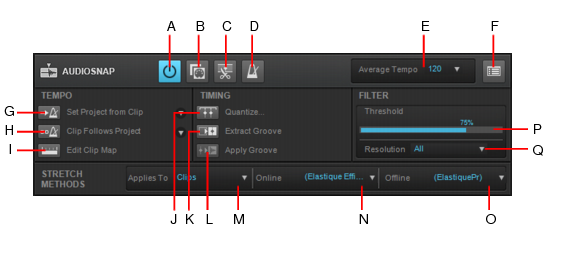



. This button saves the selected audio as a MIDI clip, which you can paste from the Clipboard into a MIDI track. You select the MIDI note that the transients in the audio clip will be converted to in the AudioSnap Options dialog box, which opens when you click the Options button.


/
. There are two timebase settings for a clip in Cakewalk:

. Musical Timebase means the clip start position will follow Musical Time (MIDI Tick).



. This button opens the AudioSnap Options dialog box. This dialog box has its own Help topic, which appears when you click its Help button.

. This button copies the clip’s tempo map to the project’s global tempo map and automatically triggers the Clip Follows Project Tempo command. This allows the project’s measure boundaries to align with the audio clip. The drop-down list lets you specify at which resolution the clip’s tempo map should be copied to the project tempo. The options are as follows:

. This button forces the clip to follow the project’s global tempo map. The drop-down list lets you specify at which resolution the clip should follow tempo changes. The options are as follows:

. Each audio clip has an internal tempo map. This button exposes controls that allow you to edit a clip’s tempo map. For details, see Editing a clip’s tempo map.

. This button opens the Quantize dialog box, which has options to quantize AudioSnap Beats and Audio Clip Start Times, and also to set automatic crossfade options.

. This button adds the selected clip’s transients to the Pool (see Using the Pool) and shows vertical Pool lines. To apply the pool (groove) to another clip, select the desired clip and click the Apply Groove button. To clear the Pool, click the Extract Groove button again.

. This button applies the currently extracted groove (Pool) to the selected clips, clears the Pool and releases the Extract Groove button. See also To quantize an audio clip to another audio clip (Quantize to Pool).




















Tip - Searching Documentation
Tip: To search for a specific topic, type your search query in the Search Cakewalk.com field at the top right of this page.
When the search results appear, click which product's documentation you would like to search to filter the search results further.
Note - Using Offline Help
Note: If you prefer to always use offline Help, go to Edit > Preferences > File > Advanced in your Cakewalk software and select Always Use Offline Help.
If you are not connected to the internet, your Cakewalk software will default to showing offline help until an internet connection becomes available.




